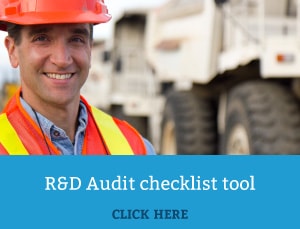Oil and Gas
December 18th, 2014
This case study exemplifies the application of key legislative requirements for eligible R&D activities as they apply to relevant activities in the oil and gas industry.
Business Scenario
SafeMark Gas Experts (SafeMark) has been involved in gas detection in the workplace for over 40 years and offers safety solutions to Australian infrastructure and resource companies. To maintain the trust of its clients and keep its industry-leading reputation, SafeMark conducts regular R&D work.
In March of 2013, SafeMark found a need for a guard that detected flammable materials which led to the start of Project Flame Guard in April of 2013. The hypothesis for its project was that SafeMark could design and develop an examined guard with innovative features to detect flammable material in an improved manner to what currently existed on the market.
Before making its initial R&D claim, SafeMark needed to determine the eligibility of its proposed R&D activities in order to know if it qualified for the R&D Tax Incentive. Once it identified the specific activities that qualified as R&D, it needed to decide whether each activity was a core or supporting R&D activity. After self-assessing, SafeMark decided to register one core activity and two supporting activities with AusIndustry in 2013.
SafeMark’s Core R&D Activity
Design and development of a series of prototypes to achieve the technical objectives (design of the examined guard).SafeMark’s hypothesis for its experiment questioned whether it was feasible to design an examined guard to detect flammable materials that was easier to use in the field and reduced operating costs for clients.
The experiments SafeMark conducted in the design phase mainly consisted of computer modelling, conceptual engineering drawings and mathematical calculations. These experiments could only be proven effective or ineffective in the prototype development and testing phase. Following the experiments in that phase, during which the product was built and tested in various applications, the design was modified and re-tested until the desired outcome was achieved.
Commentary
Identifying Core R&D Activities There are two types of core R&D activities:- Experimental activities whose outcome can not be determined in advance on the basis of current knowledge, information or experience, but can only be known by exercising a systematic progression of work that follows the principles of established science, proceeding from hypothesis to experiment, observation and evaluation, and lead to logical conclusions.
- Experimental activities that are conducted for the purpose of creating new knowledge.
Hypothesis Defined AusIndustry recognises a hypothesis as a statement or proposition about what result is expected if certain conditions are put in place and certain actions are carried out in an experiment. It can range from an assumption or proposition to a theory, but it must establish the experimental activity and form part of a broader systematic progression of work undertaken by the company. It must be evident that the claimed experiment has been designed to test the hypothesis.
If the outcome of an activity can be obtained without a hypothesis, then the activity will not be considered R&D.
SafeMark’s Supporting R&D Activities
Background research to evaluate current knowledge gaps and determine feasibility (background research for the examined guard).SafeMark’s R&D activities included the following:
- Literature search and review, including maintaining up-to-date knowledge on relevant certification and standards.
- Consultation with industry professionals and potential customers to determine the level of interest and commercial feasibility of the product.
- Preliminary equipment and resources review with respect to capacity, performance and suitability for the project.
- Consultation with key component/part/assembly suppliers to determine the factors they considered important in the design and gain an understanding of how the design needed to be structured accordingly.
The background research conducted by SafeMark qualified as a supporting R&D activity because it was directly related to the core activity of designing a guard capable of detecting flammable materials.
Ongoing analysis of customer or user feedback to improve the prototype design (feedback of the examined guard).
Feedback of the examined guard included:
- Ongoing analysis and testing to improve the efficiency and safety of the project.
- Ongoing development and modification to interpret the experimental results and draw conclusions that served as starting points for the development of new hypotheses.
- Commercial analysis and functionality review.
This feedback was necessary to evaluate the performance capabilities of the new design in the field and to improve any flaws in the design. There was a direct correlation between the feedback and the design process of the examined guard, thus making it an eligible supporting R&D activity.
Commentary
Identifying Supporting R&D Activities Activities that do not form part of the core experimental activities may still be eligible as supporting R&D activities. Supporting R&D activities are directly related to an eligible core R&D activity. They must have been performed for the primary purpose of supporting a qualified R&D activity.What records and specific documentation did SafeMark keep?
To meet the R&D Tax Incentive requirements, SafeMark had to save documents that outlined what it did in its core R&D activity, including experimental activities and documents to prove that the work took place in a systematic manner.
SafeMark saved the following documentation:
- Background research
- Meeting notes and progress reports, including internal project management issues and updates
- Conceptual sketches
- Design drawings
- Emails
By having these records on file, SafeMark confirmed that it was ‘compliance ready’ — meaning if it was audited by the ATO, it could present documentation to show the progression of its R&D activity.
Click here for the PDF version of this case study.
Categories
- ATO Guidance and Materials
- AusIndustry Guidance and Materials
- Case Law
- Federal Budget 2021
- Federal Budget 2022
- For Accountants
- General Information
- Government Policy and Treasury
- Industry Specific Issues
- Interpretative Decisions
- Legislation and Parliamentary Matters
- R&D Tax Credit
- R&D Tax Funding Strategies
- R&D Tax Loans
- Recent News
- Tax Determinations
Archives
- April 2024
- March 2024
- February 2024
- January 2024
- December 2023
- November 2023
- October 2023
- September 2023
- August 2023
- July 2023
- June 2023
- May 2023
- April 2023
- March 2023
- February 2023
- January 2023
- December 2022
- November 2022
- October 2022
- September 2022
- August 2022
- July 2022
- June 2022
- May 2022
- April 2022
- March 2022
- February 2022
- January 2022
- December 2021
- November 2021
- October 2021
- September 2021
- August 2021
- July 2021
- June 2021
- May 2021
- April 2021
- March 2021
- February 2021
- January 2021
- December 2020
- November 2020
- October 2020
- September 2020
- August 2020
- July 2020
- June 2020
- May 2020
- April 2020
- March 2020
- February 2020
- January 2020
- December 2019
- November 2019
- October 2019
- September 2019
- August 2019
- July 2019
- June 2019
- May 2019
- April 2019
- March 2019
- February 2019
- January 2019
- December 2018
- November 2018
- September 2018
- July 2018
- June 2018
- May 2018
- April 2018
- March 2018
- February 2018
- January 2018
- December 2017
- November 2017
- September 2017
- August 2017
- July 2017
- June 2017
- May 2017
- April 2017
- March 2017
- February 2017
- January 2017
- December 2016
- November 2016
- October 2016
- September 2016
- August 2016
- July 2016
- June 2016
- May 2016
- April 2016
- March 2016
- February 2016
- January 2016
- December 2015
- November 2015
- October 2015
- September 2015
- August 2015
- July 2015
- June 2015
- May 2015
- April 2015
- March 2015
- February 2015
- January 2015
- November 2014
- October 2014
- September 2014
- August 2014
- July 2014
- June 2014
- May 2014
- April 2014
- March 2014
- February 2014
- January 2014
- December 2013
- November 2013
- October 2013
- September 2013
- May 2013
- April 2013
- March 2013
- September 2012
- August 2012
- June 2012


 Free Call: 1300 009 390
Free Call: 1300 009 390





 News & Research
News & Research



